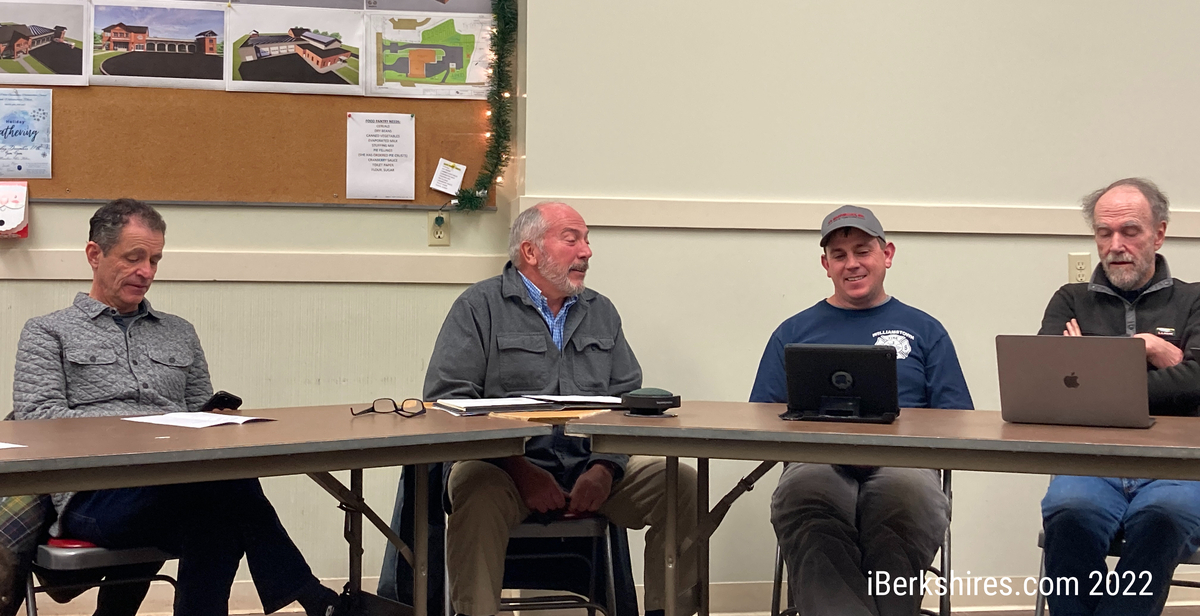Williamstown Fire District's Building Committee Discusses Site Work, Sees Cost EstimateBy Stephen Dravis, iBerkshires Staff
04:00PM / Friday, December 23, 2022 | |
 Williamstown Fire District Building Committee members, from left, Bob Menicocci, Don Dubendorf, Ryan Housman and Jim Kolesar, participate in the panel's Dec. 20 meeting. Williamstown Fire District Building Committee members, from left, Bob Menicocci, Don Dubendorf, Ryan Housman and Jim Kolesar, participate in the panel's Dec. 20 meeting. |
WILLIAMSTOWN, Mass. — The Fire District's Building Committee recently saw revised cost estimates for a new station on Main Street and discussed whether the district's site needs to be preloaded to address soil compaction before construction gets underway.
The latest estimated bottom line for the project, including so-called "soft costs," is just less than $25 million, according to the district's owners project manager, Colliers International.
The latest estimate, dated Dec. 13, of $24.9 million fell in the middle of a range of mid-November numbers from Colliers, which at the time said the project could cost between $21.8 and $28.5 million.
Williamstown Fire District officials hope to have the most precise estimate available before they go to voters to ask for bonding authority at a planned Feb. 28 special district meeting.
The latest round of projections includes roughly $100,000 for an "early site package" at 562 Main St., the property the district purchased in 2017. That $100,000 ballpark projection referred to the design-cost, on-site monitoring and other expenses beyond typical fill and removal of unusable soils.
The expense is not a big surprise. It results from a recent geotechnical study done on the site, and previous estimates have included a contingency to account for work that the geotech findings would require.
As it happens, the recent study discovered more potential for compaction than previously known.
"The second piece of information, which was surprising to me at least, was the original borings didn't go down as far as we would have liked from an engineering/design standpoint," architect Chris Wante of Pittsfield's EDM told the Building Committee at its Tuesday afternoon meeting. "What [the new borings] found was soils well below the grade are clay material with a high probability for significant settlement.
"So when we load with additional fill to bring it up above flood plain and then put a building on top, the geotech analysis showed there could be potential settlement of 6 inches, so the building would sink. Obviously, it's something we needed to address."
Wante said the geotechnical engineer hired by the district is advising that the building footprint be preloaded or "surcharged" with 3 feet of soil and then allowed to sit before construction work begins. For three to four months, engineers would then monitor the site to see what compaction occurs before proceeding with construction.
He said the surcharge work could fit into the current project timeline as an "early bid" for work that could be done in the spring and summer of next year (assuming voter approval on Feb. 28), while design documents are being finalized. The current timeline does not have construction documents finalized and the project going to bid until October 2023 with the selection of a general contractor next November.
"The thought was we'd do an early design package for the site separate from the general contractor scope," Wante said. "So the contractor for the building can hit the ground running Day One."
Building Committee member Ryan Housman asked Wante how much difference 3 feet of surcharge could make when the design already calls for between 12 and 15 inches of structural fill.
"It's a small percentage of the overall fill," Housman said. "I'm not an expert in geotech. My question is, what would it cost? Can we get a second opinion? Can someone else look at the borings?"
Wante said he could pass along the first question to the geotechnical firm and get back to the committee. The latter question prompted a conversation among the committee members about the advantages of a fresh set of eyes.
Housman pointed out that the second opinion could suggest a path that either lowers or raises the cost of the preloading work.
"If we go to someone else, they might say, 'You need 10 feet of surcharge' instead of 3 feet," he said. "Maybe we have the cheaper option already. We just don't know."
His colleagues on the committee and Bruce Decoteau, who the Prudential Committee hired as a local project coordinator to advise the district, agreed that it was worthwhile to pursue the second opinion. And the Building Committee voted unanimously to make that recommendation to the Prudential Committee, which meets on Dec. 28.
The Building Committee also recommended that the Prudential Committee authorize the architect to put together an early site package so it is ready to release for bids, if needed, right after the Feb. 28 district meeting.
The Building Committee did get some good news on the financial front on Tuesday.
District officials had been concerned that the new station's participation in the Solar Massachusetts Renewable Target [SMART] renewable energy credits program might be incompatible with the WFD's stated goal of seeking certification from the International Living Future Institute.
But committee member Jim Kolesar reported that the ILFI had told the district it could do both, keeping the district eligible for $372,000 in renewable energy credits over 20 years ($18,600 per year) as a reward for installing solar photovoltaics at the new station.
Editor's note: This story updated on July 27, 2023, to provide clarification of a cost estimate cited at the meeting.
| 
 MEMBER SIGN IN
MEMBER SIGN IN
 MEMBER SIGN IN
MEMBER SIGN IN